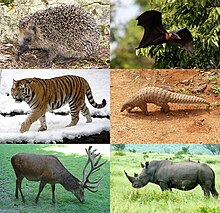
Back وحشيات شمالية Arabic وحشيات شماليه ARZ Boreoeuteris Catalan Boreoeutheria Czech Boreoeutheria German Βορεοευθήρια Greek Boreoeutheria Spanish Boreoeutheria EU شمالهوددان FA Boreoeutheria French
| Boreoeutheria Temporal range:
| |
|---|---|

| |
| From top to right: European hedgehog, Lyle's flying fox, tiger, Indian pangolin, red deer and white rhino. Representing the orders: Eulipotyphla, Chiroptera, Carnivora, Pholidota, Artiodactyla and Perissodactyla, comprising Laurasiatheria. | |

| |
| From top to right: Desmarest's hutia, Sunda colugo, brown rat, European hare, lar gibbon, human playing with a rabbit, ring-tailed lemur, and a common treeshrew. Representing the orders: Dermoptera, Rodentia, Primates, Lagomorpha, and Scandentia, comprising Euarchontoglires. | |
| Scientific classification | |
| Domain: | Eukaryota |
| Kingdom: | Animalia |
| Phylum: | Chordata |
| Class: | Mammalia |
| Clade: | Eutheria |
| Infraclass: | Placentalia |
| Magnorder: | Boreoeutheria Springer & de Jong, 2001;[1] Murphy et al., 2001[2] |
| Superorders | |
| Synonyms | |
Boreoeutheria (/boʊˌriːoʊjuːˈθɛriə/, "northern true beasts") is a magnorder of placental mammals that groups together superorders Euarchontoglires and Laurasiatheria.[1][2][5] The clade includes species as diverse as giraffes, pigs, zebras, rhinos, dogs, cats, rabbits, mice, squirrels, bats, whales, dolphins, lemurs, monkeys, and humans.
With a few exceptions,[a] male boreoeutherians have a scrotum, an ancestral feature of the clade.[6][7] The sub-clade Scrotifera was named after this feature.[8]
- ^ a b Springer MS, de Jong WW (2001). "Which mammalian supertree to bark up?". Science. 291 (5509): 1709–1711. doi:10.1126/science.1059434. PMID 11253193. S2CID 82844572.
- ^ a b Murphy WJ, Eizirik E, O'Brien SJ, Madsen O, Scally M, Douady CJ, et al. (December 2001). "Resolution of the early placental mammal radiation using Bayesian phylogenetics". Science. 294 (5550): 2348–2351. Bibcode:2001Sci...294.2348M. doi:10.1126/science.1067179. PMID 11743200. S2CID 34367609.
- ^ Arnason U., Adegoke J. A., Gullberg A., Harley E. H., Janke A., Kullberg M. (2008.) "Mitogenomic relationships of placental mammals and molecular estimates of their divergences." Gene.; 421(1-2):37–51
- ^ Cite error: The named reference
Waddell2001was invoked but never defined (see the help page). - ^ Scally M, Madsen O, Douady CJ, de Jong WW, Stanhope MJ, Springer MS (2001). "Molecular evidence for the major clades of placental mammals". Journal of Mammalian Evolution. 8 (4): 239–277. doi:10.1023/A:1014446915393. S2CID 24199924.
- ^ Mills, D. S.; Marchant-Forde, Jeremy N. (2010). The Encyclopedia of Applied Animal Behaviour and Welfare. CABI. p. 293. ISBN 978-0-85199-724-7. Retrieved 20 June 2019.
- ^ Drew, Liam (8 July 2013). "Why are testicles kept in a vulnerable dangling sac?". slate.com.
Between these branches, however, is where it gets interesting, for there are numerous groups, our descended but a-scrotal cousins, whose testes drop down away from the kidneys but don't exit the abdomen. Almost certainly, these animals evolved from ancestors whose testes were external, which means at some point they backtracked..., evolving anew gonads inside the abdomen. They are a ragtag bunch including hedgehogs, moles, rhinos and tapirs, hippopotamuses, dolphins and whales, some seals and walruses, and scaly anteaters.
- ^ Waddell; et al. (1999). "Using novel phylogenetic methods to evaluate mammalian mtDNA, including amino acid-invariant sites-LogDet plus site stripping, to detect internal conflicts in the data, with special reference to the positions of hedgehog, armadillo, and elephant". Systematic Biology. 48 (1): 31–53. doi:10.1080/106351599260427. PMID 12078643.
The name comes from the word scrotum a pouch in which the testes permanently reside in the adult male. All members of the group have a postpenile scrotum, often prominently displayed, except for some aquatic forms and pangolins (which have the testes just below the skin). It appears to be an ancestral character for this group, yet other orders generally lack this as an ancestral feature, with the probable exception of Primates.
Cite error: There are <ref group=lower-alpha> tags or {{efn}} templates on this page, but the references will not show without a {{reflist|group=lower-alpha}} template or {{notelist}} template (see the help page).